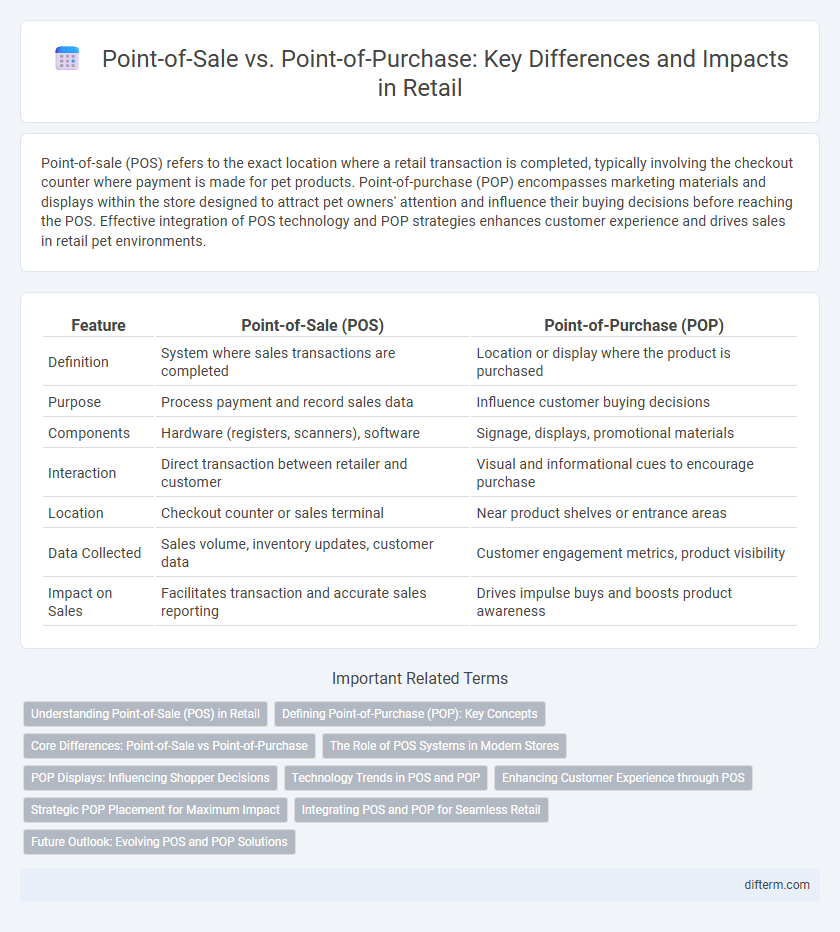Point-of-sale (POS) refers to the exact location where a retail transaction is completed, typically involving the checkout counter where payment is made for pet products. Point-of-purchase (POP) encompasses marketing materials and displays within the store designed to attract pet owners' attention and influence their buying decisions before reaching the POS. Effective integration of POS technology and POP strategies enhances customer experience and drives sales in retail pet environments.
Table of Comparison
| Feature | Point-of-Sale (POS) | Point-of-Purchase (POP) |
|---|---|---|
| Definition | System where sales transactions are completed | Location or display where the product is purchased |
| Purpose | Process payment and record sales data | Influence customer buying decisions |
| Components | Hardware (registers, scanners), software | Signage, displays, promotional materials |
| Interaction | Direct transaction between retailer and customer | Visual and informational cues to encourage purchase |
| Location | Checkout counter or sales terminal | Near product shelves or entrance areas |
| Data Collected | Sales volume, inventory updates, customer data | Customer engagement metrics, product visibility |
| Impact on Sales | Facilitates transaction and accurate sales reporting | Drives impulse buys and boosts product awareness |
Understanding Point-of-Sale (POS) in Retail
Point-of-Sale (POS) in retail refers to the exact location and system where a customer completes the transaction, involving hardware like cash registers, barcode scanners, and payment terminals integrated with software for inventory and sales management. POS systems enhance retail operations by streamlining checkout processes, tracking sales data in real-time, and managing customer information to optimize marketing efforts. Understanding POS technology is crucial for retailers aiming to improve transactional efficiency, reduce errors, and boost overall profitability.
Defining Point-of-Purchase (POP): Key Concepts
Point-of-Purchase (POP) refers to the physical location or marketing materials where a customer makes the buying decision, such as in-store displays, signage, and promotional stands. POP strategies aim to capture consumer attention and influence purchase behavior directly at or near the product location within the retail environment. Effective POP execution enhances product visibility, encourages impulse buys, and drives sales by leveraging strategic placement and compelling visual merchandising.
Core Differences: Point-of-Sale vs Point-of-Purchase
Point-of-Sale (POS) systems refer to the technology and location where customers complete their purchases, managing transactions and payment processing, while Point-of-Purchase (POP) focuses on marketing and promotional materials strategically placed to influence buying decisions at the time of sale. The core difference lies in POS handling the operational side of sales including billing and inventory updates, whereas POP drives consumer engagement through displays, signage, and product placements designed to boost impulse buying. Retailers leverage POS data for inventory management and sales analytics, whereas POP strategies aim to enhance product visibility and increase conversion rates at critical purchase moments.
The Role of POS Systems in Modern Stores
POS systems streamline retail operations by facilitating real-time inventory management, sales tracking, and customer data collection. These technologies enhance transaction speed and accuracy, improving overall customer experience while enabling personalized marketing strategies. Integration with digital payments and mobile devices positions POS as a critical tool in modern retail environments for boosting efficiency and sales performance.
POP Displays: Influencing Shopper Decisions
POP displays are crucial retail tools designed to capture shopper attention and drive impulse purchases at the point-of-purchase, directly influencing buying decisions. These strategically placed displays utilize vibrant visuals, product samples, and targeted messaging to create an engaging shopping experience, boosting brand visibility and increasing sales conversion rates. Effective POP displays can differentiate products in crowded retail environments, making them essential for maximizing ROI in retail marketing strategies.
Technology Trends in POS and POP
Point-of-Sale (POS) systems are increasingly integrating cloud computing, AI-driven analytics, and contactless payment technologies to streamline retail transactions and enhance customer experiences. Point-of-Purchase (POP) displays leverage digital signage, augmented reality, and personalized marketing algorithms to attract and engage shoppers directly at the purchase decision point. Advanced POS and POP technologies together optimize inventory management, sales tracking, and targeted promotions, driving higher conversion rates and operational efficiency in retail environments.
Enhancing Customer Experience through POS
Point-of-Sale (POS) systems streamline transactions with integrated payment processing, inventory management, and customer data tracking, enhancing personalization and efficiency at checkout. Unlike Point-of-Purchase (POP) displays that primarily influence buying decisions through in-store marketing, POS technology directly impacts customer experience by reducing wait times and offering tailored promotions. Retailers leveraging advanced POS solutions boost customer satisfaction, increase sales, and gain actionable insights into consumer behavior.
Strategic POP Placement for Maximum Impact
Strategic Point-of-Purchase (POP) placement within retail environments significantly boosts consumer engagement and drives impulse sales by capturing shoppers' attention at critical decision-making moments. Effective POP positioning near checkout counters or high-traffic aisles leverages shopper behavior data to maximize visibility and encourage last-minute purchases. Optimizing POP displays through targeted product assortment and appealing design enhances overall store profitability and brand reinforcement.
Integrating POS and POP for Seamless Retail
Integrating Point-of-Sale (POS) and Point-of-Purchase (POP) systems enhances retail efficiency by synchronizing transaction processing with in-store promotional displays, leading to improved customer engagement and sales conversion. Real-time data exchange between POS terminals and dynamic POP signage allows for personalized offers and inventory updates, optimizing the shopping experience. This seamless integration supports unified analytics, enabling retailers to tailor marketing strategies and streamline operations effectively.
Future Outlook: Evolving POS and POP Solutions
The future of retail hinges on the integration of Point-of-Sale (POS) and Point-of-Purchase (POP) technologies, enhancing customer engagement and streamlining transactions. Advanced POS systems leverage AI-driven analytics and mobile payment solutions to optimize inventory management and personalized marketing at POP displays. Retailers adopting these evolving solutions can expect increased conversion rates and enriched shopping experiences amid growing digital transformation.
Point-of-Sale vs Point-of-Purchase Infographic

 difterm.com
difterm.com